[English] 日本語
 Yorodumi
Yorodumi- EMDB-6774: Cryo-EM structure of human respiratory complex III (cytochrome bc... -
+ Open data
Open data
- Basic information
Basic information
| Entry | Database: EMDB / ID: EMD-6774 | |||||||||
|---|---|---|---|---|---|---|---|---|---|---|
| Title | Cryo-EM structure of human respiratory complex III (cytochrome bc1 complex) | |||||||||
 Map data Map data | This map was obtained by sub-region refinement. | |||||||||
 Sample Sample |
| |||||||||
| Function / homology |  Function and homology information Function and homology informationComplex III assembly / Complex III assembly / Complex III assembly / Complex III assembly / Complex III assembly / response to D-galactosamine / Complex III assembly / Complex III assembly / Complex III assembly / Complex III assembly ...Complex III assembly / Complex III assembly / Complex III assembly / Complex III assembly / Complex III assembly / response to D-galactosamine / Complex III assembly / Complex III assembly / Complex III assembly / Complex III assembly / response to mercury ion / Respiratory electron transport / subthalamus development / pons development / response to cobalamin / cerebellar Purkinje cell layer development / mitochondrial respiratory chain complex III assembly / pyramidal neuron development / response to alkaloid / cellular respiration / thalamus development / Mitochondrial protein import / respiratory chain complex / respiratory chain complex III / oxidative phosphorylation / quinol-cytochrome-c reductase / response to glucagon / quinol-cytochrome-c reductase activity / response to copper ion / mitochondrial electron transport, ubiquinol to cytochrome c / hypothalamus development / midbrain development / electron transport coupled proton transport / response to hyperoxia / animal organ regeneration / response to cadmium ion / Mitochondrial protein degradation / aerobic respiration / response to activity / respiratory electron transport chain / generation of precursor metabolites and energy / hippocampus development / response to calcium ion / metalloendopeptidase activity / 2 iron, 2 sulfur cluster binding / response to toxic substance / response to ethanol / response to hypoxia / oxidoreductase activity / electron transfer activity / mitochondrial inner membrane / mitochondrial matrix / response to xenobiotic stimulus / heme binding / ubiquitin protein ligase binding / protein-containing complex binding / mitochondrion / proteolysis / nucleoplasm / metal ion binding / nucleus / membrane Similarity search - Function | |||||||||
| Biological species |  Homo sapiens (human) Homo sapiens (human) | |||||||||
| Method | single particle reconstruction / cryo EM / Resolution: 3.4 Å | |||||||||
 Authors Authors | Gu J / Wu M / Yang M | |||||||||
 Citation Citation |  Journal: Cell / Year: 2017 Journal: Cell / Year: 2017Title: Architecture of Human Mitochondrial Respiratory Megacomplex IIIIIV. Authors: Runyu Guo / Shuai Zong / Meng Wu / Jinke Gu / Maojun Yang /  Abstract: The respiratory megacomplex represents the highest-order assembly of respiratory chain complexes, and it allows mitochondria to respond to energy-requiring conditions. To understand its architecture, ...The respiratory megacomplex represents the highest-order assembly of respiratory chain complexes, and it allows mitochondria to respond to energy-requiring conditions. To understand its architecture, we examined the human respiratory chain megacomplex-IIIIIV (MCIIIIIV) with 140 subunits and a subset of associated cofactors using cryo-electron microscopy. The MCIIIIIV forms a circular structure with the dimeric CIII located in the center, where it is surrounded by two copies each of CI and CIV. Two cytochrome c (Cyt.c) molecules are positioned to accept electrons on the surface of the c state CIII dimer. Analyses indicate that CII could insert into the gaps between CI and CIV to form a closed ring, which we termed the electron transport chain supercomplex. The structure not only reveals the precise assignment of individual subunits of human CI and CIII, but also enables future in-depth analysis of the electron transport chain as a whole. | |||||||||
| History |
|
- Structure visualization
Structure visualization
| Movie |
 Movie viewer Movie viewer |
|---|---|
| Structure viewer | EM map:  SurfView SurfView Molmil Molmil Jmol/JSmol Jmol/JSmol |
| Supplemental images |
- Downloads & links
Downloads & links
-EMDB archive
| Map data |  emd_6774.map.gz emd_6774.map.gz | 22.1 MB |  EMDB map data format EMDB map data format | |
|---|---|---|---|---|
| Header (meta data) |  emd-6774-v30.xml emd-6774-v30.xml emd-6774.xml emd-6774.xml | 10 KB 10 KB | Display Display |  EMDB header EMDB header |
| Images |  emd_6774.png emd_6774.png | 18.2 KB | ||
| Archive directory |  http://ftp.pdbj.org/pub/emdb/structures/EMD-6774 http://ftp.pdbj.org/pub/emdb/structures/EMD-6774 ftp://ftp.pdbj.org/pub/emdb/structures/EMD-6774 ftp://ftp.pdbj.org/pub/emdb/structures/EMD-6774 | HTTPS FTP |
-Validation report
| Summary document |  emd_6774_validation.pdf.gz emd_6774_validation.pdf.gz | 312.8 KB | Display |  EMDB validaton report EMDB validaton report |
|---|---|---|---|---|
| Full document |  emd_6774_full_validation.pdf.gz emd_6774_full_validation.pdf.gz | 312.3 KB | Display | |
| Data in XML |  emd_6774_validation.xml.gz emd_6774_validation.xml.gz | 7.6 KB | Display | |
| Arichive directory |  https://ftp.pdbj.org/pub/emdb/validation_reports/EMD-6774 https://ftp.pdbj.org/pub/emdb/validation_reports/EMD-6774 ftp://ftp.pdbj.org/pub/emdb/validation_reports/EMD-6774 ftp://ftp.pdbj.org/pub/emdb/validation_reports/EMD-6774 | HTTPS FTP |
-Related structure data
| Related structure data |  5xteMC  6771C  6772C  6773C  6775C  6776C  5xtbC  5xtcC  5xtdC  5xthC  5xtiC M: atomic model generated by this map C: citing same article ( |
|---|---|
| Similar structure data |
- Links
Links
| EMDB pages |  EMDB (EBI/PDBe) / EMDB (EBI/PDBe) /  EMDataResource EMDataResource |
|---|---|
| Related items in Molecule of the Month |
- Map
Map
| File |  Download / File: emd_6774.map.gz / Format: CCP4 / Size: 421.9 MB / Type: IMAGE STORED AS FLOATING POINT NUMBER (4 BYTES) Download / File: emd_6774.map.gz / Format: CCP4 / Size: 421.9 MB / Type: IMAGE STORED AS FLOATING POINT NUMBER (4 BYTES) | ||||||||||||||||||||||||||||||||||||||||||||||||||||||||||||
|---|---|---|---|---|---|---|---|---|---|---|---|---|---|---|---|---|---|---|---|---|---|---|---|---|---|---|---|---|---|---|---|---|---|---|---|---|---|---|---|---|---|---|---|---|---|---|---|---|---|---|---|---|---|---|---|---|---|---|---|---|---|
| Annotation | This map was obtained by sub-region refinement. | ||||||||||||||||||||||||||||||||||||||||||||||||||||||||||||
| Projections & slices | Image control
Images are generated by Spider. | ||||||||||||||||||||||||||||||||||||||||||||||||||||||||||||
| Voxel size | X=Y=Z: 1.083 Å | ||||||||||||||||||||||||||||||||||||||||||||||||||||||||||||
| Density |
| ||||||||||||||||||||||||||||||||||||||||||||||||||||||||||||
| Symmetry | Space group: 1 | ||||||||||||||||||||||||||||||||||||||||||||||||||||||||||||
| Details | EMDB XML:
CCP4 map header:
| ||||||||||||||||||||||||||||||||||||||||||||||||||||||||||||
-Supplemental data
- Sample components
Sample components
-Entire : Human respiratory complex III
| Entire | Name: Human respiratory complex III |
|---|---|
| Components |
|
-Supramolecule #1: Human respiratory complex III
| Supramolecule | Name: Human respiratory complex III / type: complex / ID: 1 / Parent: 0 / Macromolecule list: #1-#11 / Details: Human cytochrome bc1 complex |
|---|---|
| Source (natural) | Organism:  Homo sapiens (human) Homo sapiens (human) |
| Molecular weight | Experimental: 500 KDa |
-Experimental details
-Structure determination
| Method | cryo EM |
|---|---|
 Processing Processing | single particle reconstruction |
| Aggregation state | particle |
- Sample preparation
Sample preparation
| Buffer | pH: 7.4 |
|---|---|
| Vitrification | Cryogen name: ETHANE |
- Electron microscopy
Electron microscopy
| Microscope | FEI TITAN KRIOS |
|---|---|
| Image recording | Film or detector model: FEI FALCON II (4k x 4k) / Average electron dose: 1.25 e/Å2 |
| Electron beam | Acceleration voltage: 300 kV / Electron source:  FIELD EMISSION GUN FIELD EMISSION GUN |
| Electron optics | Illumination mode: OTHER / Imaging mode: BRIGHT FIELD |
| Experimental equipment |  Model: Titan Krios / Image courtesy: FEI Company |
- Image processing
Image processing
| CTF correction | Software - Name: CTFFIND (ver. 3.0) |
|---|---|
| Final reconstruction | Applied symmetry - Point group: C1 (asymmetric) / Resolution.type: BY AUTHOR / Resolution: 3.4 Å / Resolution method: FSC 0.143 CUT-OFF / Software - Name: RELION (ver. 1.4) / Number images used: 167761 |
| Initial angle assignment | Type: RANDOM ASSIGNMENT / Software - Name: RELION (ver. 1.4) |
| Final angle assignment | Type: RANDOM ASSIGNMENT / Software - Name: RELION (ver. 1.4) |
 Movie
Movie Controller
Controller


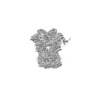
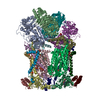


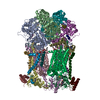

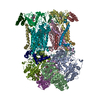
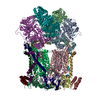









 Z (Sec.)
Z (Sec.) Y (Row.)
Y (Row.) X (Col.)
X (Col.)





















